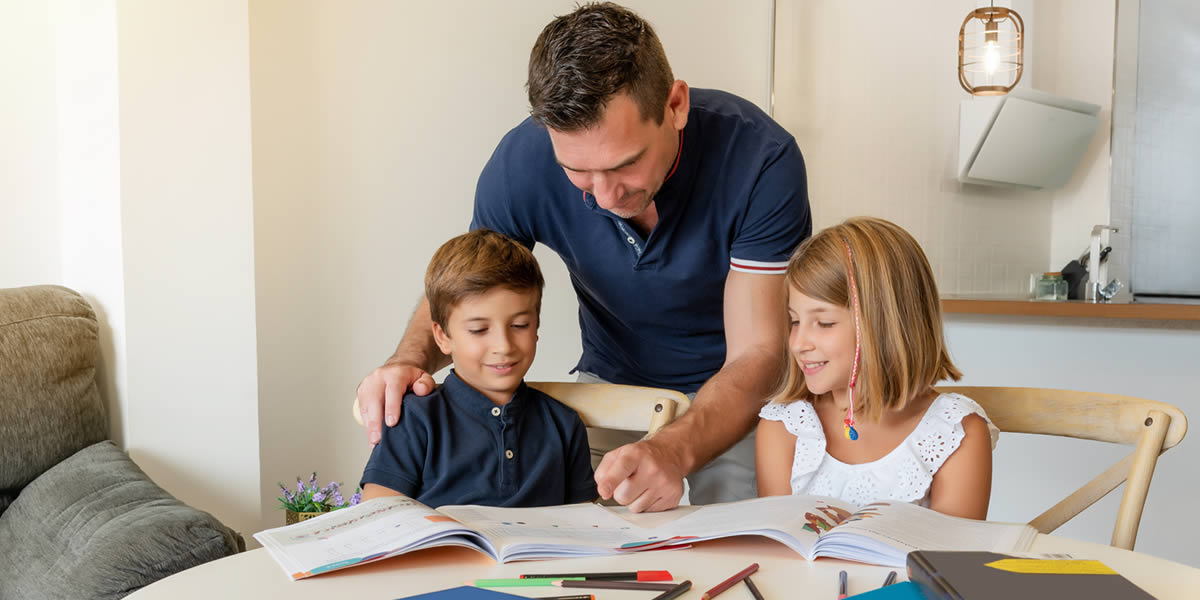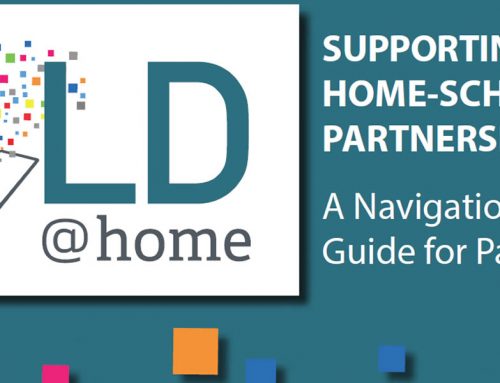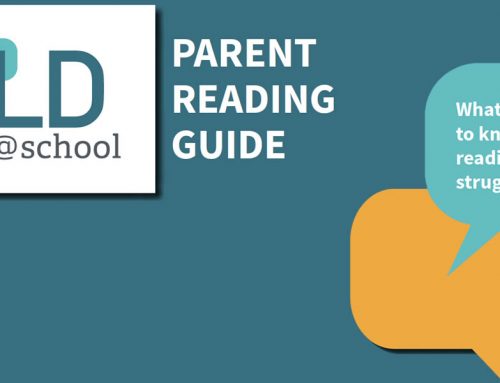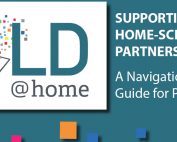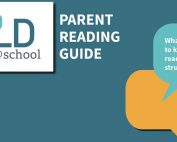Reading is not an innate or natural process; everyone must learn to read, starting from the basics. Children with learning disabilities (LDs) may progress at a slower rate than other children, but, with the right supports, they can become competent and confident readers.
Parents play a significant role in supporting children’s reading development, from a very young age, all the way through the elementary school years.
Ages 2 to 4 (Preschool)
Oral Language Development
Before children can learn to read, they must develop their oral language skills – in other words, speaking and listening. There are many things that parents can do to help their children develop these skills – such as singing songs, naming objects, or playing word games – and many parents do these things without even thinking about it.
The suggestions below are just three among many strategies to support your child’s oral language, as a foundation for reading.
What can you do?
- Speak naturally to your child, using clear, simple sentences that they can understand. By speaking properly, you provide a good language model for your child to copy and learn from.
- When your child speaks, give them your full attention and encourage their efforts by responding to what they said. If they used any “baby language” or made any mistakes, don’t correct them; rather respond by reformulating what they said into proper language.
- Ask your child questions. Ask them to name things, to help expand their vocabulary. Ask them questions about something they told you. Ask them questions that require a choice. By asking questions, you encourage them to respond and develop their oral language, and at the same time, you get a glimpse into what they know or don’t yet know. (American Speech-Language-Hearing Association, n.d.)
The Building Blocks of Reading
According to Reading Rockets (n.d.a), how easily children learn to read in grade one is strongly related to what they know before entering school. They list the following three factors as the main predictors of reading success:
- General knowledge about print, such as:
- how to hold a book
- how to turn the pages
- where to look on the page
- Ability to recognize and name the letters of the alphabet
- Awareness of different sounds within words
What can you do?
To help your child develop these skills, the single most important thing you can do is to read aloud with your child (Adams, 1990). By doing so, you will provide your child with a model of what reading looks like and sounds like. Not to mention that this can be an enjoyable and calming activity before bedtime.
Aside from reading aloud, here are some other tips to support your child’s pre-reading skills (Fitzer & Hale, 2015):
- Teach letter shapes and sounds in a fun and playful way. Start with the first letter of their name to make it meaningful to them.
- Play word games. For example, name as many things as you can that start with the /b/ sound. Or, think of a word that rhymes with “cat”.
- Recite familiar nursery rhymes and sing familiar songs.
If Your Child is Struggling
It can be very difficult for parents to know whether their children are progressing “normally” with these pre-reading skills. Reading Rockets has developed a screener tool for parents to use with their 4-year-olds, in order to get a sense of whether they are on track. Click here to access the Reading Rockets Ready to Read Screening Tool for 4-year-olds.
If your child is struggling, continue to reinforce their oral language and pre-reading skills by following the tips above, but also speak to your pediatrician about your observations. Early identification of challenges can be a crucial piece to successful intervention.
Ages 4 to 9 (Kindergarten to Grade 3)
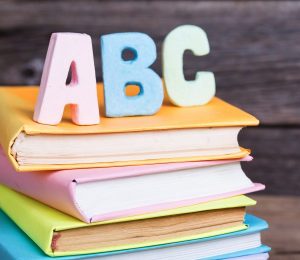 From ABCs to “I Can Read”
From ABCs to “I Can Read”
It is during these school years that most children will:
- learn the mechanics of reading
- develop reading comprehension skills
- develop the ability to make inferences and connect what they read to their own experiences
What can you do?
The Ontario Ministry of Education developed a guide for parents in 2007, called Helping your Child with Reading and Writing. In this guide, they present the following tips:
- Talk With Your Child
- Make Reading and Writing Fun
- Read Every Day
- Talk About Books
- Listen to Your Child Read
- Set an Example for Your Child
This guide was updated in 2014. The new version reframes the tips above, and includes links to interactive online resources that children can use to practice their reading skills. Click here to access the updated guide Reading and Writing with your Child.
If Your Child is Struggling
Understand the Problem
Because so many literacy skills are taught between kindergarten and grade 3, this is often the time when reading challenges become apparent. Here are some clues to look for if you suspect your child may be falling behind compared to their peers (Reading Rockets, n.d.b.):
- difficulty rhyming
- difficulty hearing individual sounds
- difficulty following directions
- difficulty re-telling a story
- difficulty sounding out most words
- avoiding reading aloud
If your concerns persist, record your observations, and compare your observations with your child’s teacher. Ask them what they have noticed, whether they have any concerns, and what strategies they are using with your child. Try reinforcing those strategies at home by using them while reading with your child.
Check out these websites for further suggestions about understanding your child’s area of difficulty and strategies to support them.
Click here to access the Reading Rockets resource Target the Problem.
It is important to note, however, that learning disabilities (LDs) are complex, and while parents and teachers often see the difficulties that result from the LDs, they may not be able to identify the area of processing that causes the problem. It is critical to obtain a psychoeducational assessment from a trained psychologist if you suspect your child is truly struggling. For more information, click here to view the video An Introduction to the Psychoeducational Assessment.
Resources for Parents
Below are some resources that parents can use at home to support their children who struggle with reading.
Dolch Sight Words:
To read effectively, many different skills must be activated simultaneously. One skill that can help readers become faster and more fluent is the ability to quickly identify common words. Many websites offer lists of Dolch sight words, over 200 high-frequency words, for different grade levels. Turn these lists into cue cards, and practice them with your child every day. Remember to make it fun, only practice for short intervals of time, and congratulate them when they are successful.
Ages 9 to 12 (Grades 4 to 6)
Reading to Learn
It is during these school years that most children become fluent readers and learn to interpret effectively the information they have read. At this stage, reading becomes a tool for learning about other subjects. The EQAO standardized reading test administered in Grade 6 scores students on their ability to (EQAO, 2016):
- make accurate predictions, inferences and interpretations about the ideas, people and events in reading materials
- draw clear and insightful conclusions about the situations and problems in what they read
- support their opinions with relevant and specific details from reading materials
- connect their interpretations to their background knowledge and personal experiences
What can you do?
The guide Helping your Child with Reading and Writing presents the following tips for parents of children in grades 4 to 6:
- Help Your Child Understand What He or She Reads
- Talk With Your Child
- Make Reading Enjoyable
- Encourage Your Child to Write
- Bring Literacy to Life Through the Arts
- Be a Positive Role Model
- Bring “Critical Literacy” Into Your Home
If Your Child is Struggling
 If your child is struggling with reading at this stage, continue to use all of the strategies outlined in this article. Also make a strong effort to collaborate with the school team, which may include the classroom teacher, the principal, a resource teacher, a speech-language pathologist, and other para-professionals. Ask questions to understand what support they are offering your child and what you can do at home to reinforce what is being done at school.
If your child is struggling with reading at this stage, continue to use all of the strategies outlined in this article. Also make a strong effort to collaborate with the school team, which may include the classroom teacher, the principal, a resource teacher, a speech-language pathologist, and other para-professionals. Ask questions to understand what support they are offering your child and what you can do at home to reinforce what is being done at school.
SQ3R
One tool that can be used to support the development of reading comprehension skills is the SQ3R mnemonic (Survey, Question, Read, Recite, Review). This mnemonic helps to structure and guide the reading process in order to develop effective reading skills for comprehension.
Click here to open a PDF description of the SQ3R mnemonic from the LD@school website.
At the Survey stage, the reader looks at the pages they are about to read in order to get clues about the story or text. By quickly scanning the title, sub-headings, pictures, charts, and bolded words, they will activate whatever prior knowledge they have about the topic, which will help prepare them to understand the text.
At the Question stage, the reader formulates some questions about the passage they will read. Try asking a question using each of the WH question words (who, what, where, when, why, how). This prepares them to look out for the answers while they read, which should help them grasp the main ideas of the text.
At the Read stage, the reader breaks the passage into smaller chunks (paragraphs, chapters, or sections), and actively reads the first one, looking for answers to their questions as well as other important information.
At the Recite stage, the reader explains the section they have read in their own words and mentions any questions that have been answered and any other important information. This stage acts as a self-check to ensure that they are reading actively and understanding the key points.
At the Review stage, the reader checks that their Recite explanation was accurate and complete. Then, they may continue reading the next section of text and repeat the 3R stages until the entire text has been read.
References
Adams, M. (1990). Beginning to Read: Thinking and Learning about Print. Cambridge, MA: MIT Press.
American Speech-Language-Hearing Association. (n.d.). Activities to Encourage Speech and Language Development. Retrieved from http://www.readingrockets.org/article/activities-encourage-speech-and-language-development
EQAO. (2016). EQAO’s Assessment of Reading, Writing and Mathematics, Junior Division (Grades 4-6). Retrieved from http://www.eqao.com/en/assessments/junior-division/DMA-docs/sample-individual-student-report-junior.pdf
Fitzer, K. R., & Hale, J. B. (2015). Teaching the Brain to Read: Strategies for Improved Decoding, Fluency, and Comprehension. Retrieved from https://www.ldatschool.ca/teaching-the-brain-to-read-strategies-for-enhancing-reading-decoding-fluency-and-comprehension/
Reading Rockets. (n.d.a). Top 10 Things You Should Know About Reading. Retrieved from http://www.readingrockets.org/article/top-10-things-you-should-know-about-reading
Reading Rockets. (n.d.b). Recognizing Reading Problems. Retrieved from http://www.readingrockets.org/article/recognizing-reading-problems
Wagner, D. (2015). Strategies to Assist Students with LDs. Retrieved from https://www.ldatschool.ca/strategies-to-assist-students-with-lds/

